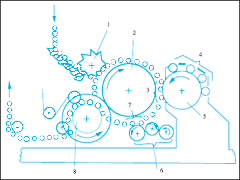3, iron printing process
â—† printing machine. Iron printing machines mainly include flatbed and rotary offset presses. The platform offset printing press adopts manual refeeding, the production efficiency is very low, and the printed sheet size is small. The rotary machine uses a two-color machine as the main model, but due to the non-absorption of the iron sheet, it is not possible to perform multi-color wet-press printing, and only two-tone printing can be performed on a screen with less overlap. The printing section of the rotary machine consists of a plate cylinder (P), a blanket cylinder (B), an impression cylinder (I), an inking device, and a wetting device. The basic structure is shown in FIG. 1 .

Figure 1: Composition of a metal plate lithographic offset printing press
Recently, some companies set up a UV drying device between printing cylinders and developed a four-color metal plate lithographic offset printing machine, as shown in Fig. 2. In order to increase the printing speed, favorable conditions have been created to realize high-speed, multi-color printing, but UV inks are used.

Figure 2: Four-color metal plate lithographic offset printing machine 1. Feeding section 2. Printing section 3. Painting section 4. Drying section 5. Turnover section 6. Receiving section 7. UV light source
In iron offset printing, hard blankets and rigid liners should be used, otherwise the dots will be poorly reproduced. The press should have sufficient accuracy and strictly control the drum lining size. If using UV inks, special rubber sticks and blankets should be used.
The printing of metal cans is often done on the automatic forming line of the cans, where painting and printing are part of the production line. Nowadays, metal cans, which are more commonly used, are mainly tinplate cans and aluminum cans. After molding, they are subjected to washing and surface treatment before coating and printing. Metal can printing machine printing speed is relatively high (400 ~ 1200 / min), generally do not use lithographic offset printing method and use dry offset printing, that is photosensitive resin relief printing, through the rubber roller transfer printing, printing color number to 4 The color machine is a standard model, and its working principle is shown in Figure 3.

Figure 3: Four-color offset press for metal cans 1. Feed star wheel
2. Mandrel turntable 3. Printing area 4. Plate cylinder 5.
Rubber roller 6. Polishing unit 7. Polishing area 8.
Output device
â—† Drying device. Tin materials are not absorbent and must be placed in a desiccator for drying, whether they are under coating or after printing or glazing.
There are two types of drying devices: heat drying and UV irradiation curing devices. The heating temperature and drying time of the heating and drying influence the drying effect and affect the quality of the printed matter. Ultraviolet curing inks must be used for UV irradiation.
Dry roasting is an important part of printing iron production, and cross-linking reaction occurs through the baked ink connecting material. The formation of a network structure makes the ink film hard and durable.
â—† Printing ink. Because the iron sheet is not absorbent, and the printed iron sheet must be machined and processed, the iron ink should have different characteristics from ordinary offset inks. a. Dryness and heat resistance of the ink. The ink film of the printing ink ink is cured by heating, so the white ink after heating is required not to change color, and the coating oil does not lose light. b. Solubility resistance. The printed varnish contains all kinds of solvents. In order to prevent bleed-through during coating, the ink should have good solvent resistance. c. resistance to cooking. The ink of the printing ink should keep the color and luster unchanged after high-temperature sterilization. The ink film cannot be B-colored, diffused or swelled due to wet steam. d. Process resistance. Most of the printed iron products must be stamped, punched, bent, closed, and other processes, so the ink film on the surface of the iron sheet should have a strong structure, and should not fall off or be damaged during processing and after processing. Therefore, it is required that the printing ink must have good adhesion, softness, toughness, surface hardness and impact strength. e. Lightfastness and weatherability. Since various kinds of daily necessities are generally stored for a long time, they cannot be faded or aged due to light irradiation or climatic factors.
As the drying and baking process in the printing iron process is costly and time consuming, it sometimes causes discoloration of the ink, so the UV curing ink has been widely used in the iron printing process.
(to be continued)
Self-Inking Stamp Ink,Self Inking Stamp Ink,Black Stamp Ink,Office Stamp Refill Ink
Huhua Stationary Co., Ltd , https://www.huhuastamp.com